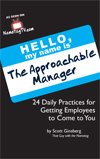 Nobody cares what you’ve done.
Nobody cares what you’ve done.
They only care what you’ve LEARNED – and – how what you’ve learned can be applied to their world in a practical, actionable way.
That’s the secret to being an inspiration to others:
Transforming “How I did” into “How you can.”
As I mentioned in How to become the Most Inspirational Person You Know, the word “inspire” derives from the Latin inspiraire, which means, “to breathe into.”
So, what approachable leaders breathe into people is POSSIBILITY. And whether you’re writing, presenting or working with someone one-on-one, here’s a compendium of practices to help you do so:
1. Accelerate the actionability of your message. “I believe this! I can do this! I want to try this!” That’s what your readers, listeners, viewers, subscribers and audience members need to think after they’ve been exposed to your ideas. That they can take action. So, in order to move from “How I did” to “How you can,” consider compounding your message with action items like:
o An exercise to do that bridges what you said into their unique situation.
o A checklist could to keep people accountable and consistent in the future.
o An assignment that, when they’ve completed it, people will be ready to move forward.
o An equation (algorithm, formula, system, etc.) people can easily plug themselves, their situation or their company into.
BREATHE IN: You words become persuasive the moment someone is compelled to take action as a result of being exposed to them. How actionable are you?
2. Challenge people. Let’s say you’re telling a story about an obstacle you overcame. Either in a conversation, during a presentation or in a piece of writing. Here’s what you do: First, once the story is over, allow it to land. Embrace the pause. This increases the probability that your words profoundly penetrate people.
Then, call to the hearts and minds of your audience by using phrases like, “I invite you to reflect with me,” “Consider this question,” “Plug yourself into the following equation” and “Ask yourself how good you are at these things.”
BREATHE IN: Language like this immediately 180’s the message and moves the story from Me Land to You Land. How challenging are you?
3. Help people. In a few different ways. First, help people absorb and understand what you said. But allow things to unfold at their speed. Do this by becoming a master at letting the pearl sink. Second, help people see their field of possibilities. Ask them how they would coach themselves through this situation.
Do this by asking people Back to the Future Questions. Lastly, help people build long-term, self-generative capabilities. Feed the development of self-reliance. Do this by becoming a listening midwife, that is, helping others give birth to their own understanding.
BREATHE IN: Let people lead themselves. What are you helping people do?
4. Throw people lifelines. If you’re a leader, odds are, you’re not normal. And don’t worry – this isn’t a bad thing. The only challenge is making sure your message stays relevant and relatable. Otherwise “How you did” is perceived as “How the hell am I supposed to?”
For example, I’m a writer. That’s what I do. That’s my occupation. And, sure: I’m also a speaker, coach, consultant and entrepreneur. But writing is my occupation inasmuch as it occupies most of my workday. As such, I spend four to seven hours writing, every day.
Four to seven hours.
Now, upon hearing such a number, most think, “Good god. Four to seven hours? But I don’t have that kind of time to write!” And naturally, I respect that. Because it would be ridiculous to expect my clients, workshop attendees and readers to invest that kind of time each day.
So, I challenge people to start with fifteen minutes a day. That’s it. If you do the math, that comes out to 1/100th of your daily allotted time. (I don’t think that’s asking too much!) In fact, when I started my career as a writer in 2002, fifteen minutes was the unit of writing time I started out with. And if I can do it, so can you.
That’s a perfect example of a lifeline. You inspire others to function at a higher level by telling them to take action things in the context of their unique situation. You breathe life into people’s hopes and dreams by meeting them where they are.
BREATHE IN:Don’t run the risk of people thinking, “Oh, but I could never do that…” What lifeline could you throw them?
5. Democratize your experiences. Open the curtain. Simplify and demystify your message. First, ask yourself questions like, “What is the universal human emotion here?” “How could what I endured relate TO (and offer help FOR) people who aren’t like me?” and “What lessons are inherent within my experience that anybody could apply to their own life?
This line of thinking builds a generic equation your followers can plug themselves into. Second, answer those questions with nuggets, keepers, pebbles, one-liners and other digestible forms of wisdom. Third, you physically write those answers down. And fourth, you articulate those chunks of wisdom to stick the landing of the message you’re delivering.
BREATHE IN: Move people’s hearts and engage their capacity to dream. How democratic is your message?
6. Inspire others with a vision of what they can contribute. Reflect their reality. Show them what they know. Make them aware of their abundant, inherent treasures. One way to do this is to offer your attention and acknowledgment of another person’s contributions to your worldview.
For example, after having a conversation with someone, type out your notes into a bullet-point list. Then email your keepers to that person later that day. Not only does it prove you were listening, not only does it honor the other person, but it helps people see the brilliance they didn’t realize they possessed.
BREATHE IN: Inspire people to continue contributing in their own unique way. How do you reflect genius back to others?
– – –
REMEMBER: The secret to inspiring people isn’t sharing what you’ve done, but rather, what you’ve learned.
AND, the practical application of what you’ve done to their unique situation.
Otherwise “How I did” morphs into “How the hell am I supposed to?”
LET ME ASK YA THIS…
How actionable, relatable and translatable is your message?
LET ME SUGGEST THIS…
For the list called, “7 Ways to Radically Raise Receptivity of Those You Serve,” send an email to me, and I’ll send you the list for free!
* * * *
Scott Ginsberg
That Guy with the Nametag
Author, Speaker, Coach, Entrepreneur
[email protected]
 Never the same speech twice.
Never the same speech twice.
Always about approachability.
Watch The Nametag Guy in action here!

 Here’s the most dangerous thought your audience members could EVER have:
Here’s the most dangerous thought your audience members could EVER have: Download a free copy of The Nametag Guy’s (unofficial) 9th book!
Download a free copy of The Nametag Guy’s (unofficial) 9th book! “Why doesn’t anybody follow me on Twitter? This sucks!”
“Why doesn’t anybody follow me on Twitter? This sucks!” We’ve been exploring the impending dangers of unapproachable leaders in
We’ve been exploring the impending dangers of unapproachable leaders in  I have three questions for you:
I have three questions for you: Every science class you’ve ever taken in your life will confirm the following biological truism:
Every science class you’ve ever taken in your life will confirm the following biological truism: 
 1. Accept bad news without the need for sugarcoating. That way, your people can give it to you straight. They can feel comfortable reporting negative information without the fear of being reamed by your emotional reactivity.
1. Accept bad news without the need for sugarcoating. That way, your people can give it to you straight. They can feel comfortable reporting negative information without the fear of being reamed by your emotional reactivity.  When you’re willing to put it all on the line for something. That’s when you’re ready.
When you’re willing to put it all on the line for something. That’s when you’re ready. Who’s quoting YOU?
Who’s quoting YOU? About once a month, I get an email from a reader who kindly points out a typo in one of my books.
About once a month, I get an email from a reader who kindly points out a typo in one of my books. This month we’ve been exploring the “Impending Dangers of Inapproachability.”
This month we’ve been exploring the “Impending Dangers of Inapproachability.”